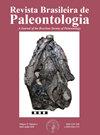IF 0.6
4区 地球科学
Q4 PALEONTOLOGY
引用次数: 0
摘要
Ribeira de Iguape Valley位于巴西东南部,是一个重要的岩溶区,这里有大量含有脊椎动物化石和亚化石物质的洞穴。Abismo Ponta de Flecha洞穴是一个复杂的垂直洞穴,分为画廊,收集了大量的骨材料。这个洞穴是一些类群的天然陷阱,也可能是古代人类社区的处置地点。在区系组合中鉴定出两属的骨皮和附骨。最丰富的骨骼材料属于衣虫科,Cabassous属,以现存的物种C. tatouay和一个较大但鲜为人知的物种的遗骸为代表,如C. antiquus。另一个已确定的属属于Dasypodidae: Dasypus sp.人类活动的证据仅在一个C. tatouay骨中被表征,而其他标本被认为是自然起源的。关键词:第四纪,衣蝇科,水蚤,Cabassous,分类本文章由计算机程序翻译,如有差异,请以英文原文为准。
Cingulata of the Abismo Ponta de Flecha Cave (Pleistocene-Holocene), Ribeira de Iguape Valley, southeastern Brazil
The Ribeira de Iguape Valley, located in southeastern Brazil, is an important karstic region, presenting a large number of caves containing fossil and subfossil vertebrate materials. The Abismo Ponta de Flecha Cave is a complex vertical cave divided into galleries where a large amount of osteological material was collected. The cave acted as a natural trap for several taxa and possibly as a disposal site for ancient human communities. Osteoderms and appendicular bones assigned to two genera of Cingulata were identified in the faunal assemblage. The most abundant bone material belongs to the family Chlamyphoridae, genus Cabassous, represented by the living species C. tatouay and by remains of a larger, but little-known species, cf. C. antiquus. The other identified genus belongs to the family Dasypodidae: Dasypus sp. Evidence of human activity was characterized in only one C. tatouay bone, while the other specimens were considered as being of natural origin. Keywords: Quaternary, Chlamyphoridae, Dasypus, Cabassous, taxonomy.
求助全文
通过发布文献求助,成功后即可免费获取论文全文。
去求助
来源期刊

Revista Brasileira De Paleontologia
PALEONTOLOGY-
CiteScore
1.60
自引率
14.30%
发文量
25
审稿时长
>12 weeks
期刊介绍:
It publishes original contributions on all aspects of Paleontology. Papers are written in English, Spanish, or Portuguese and are reviewed by international experts.
 求助内容:
求助内容: 应助结果提醒方式:
应助结果提醒方式:


